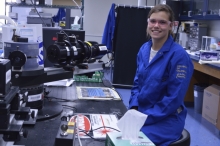
University:
Major:
Mentor(s):
Faculty Sponsor(s):
Faculty Sponsor's Department:
Project Title:
Project Description:
Nanogels are important tunable release systems in the biomedical field. These nanoparticle hydrogels consist of polymeric gel networks that are formed through covalent or non-covalent crosslinking. Of special interest is the development of new facile non-covalent crosslinking methods since these represent mild processing conditions for the encapsulation of sensitive functional payloads. Inspired by nature’s strategy of forming exceptionally strong non-covalent bonds via complex coacervation in aqueous surroundings, we are aiming to exploit this concept as new crosslinking method in synthetic nanogels. Ideally, an efficient preparation method to such colloidal nanocarriers would be surfactant free and completely water based. To approach this challenge, we are investigating the formation of coacervate hydrogel nanoparticles directly in aqueous solutions. For this we are simply mixing aqueous solutions of PEO-based copolymers and polysaccharides. Nanoparticle formation then occurs through coacervate crosslinking between the polyelectrolyte blocks and the oppositely charged biopolymer. Additionally, the PEG chains of the copolymers ensure colloidal stability and therefore replace the surfactant. Furthermore, utilization of biopolymers such as hyaluronic acid renders the resulting nanocarriers bio-degradable. The size of the particles will be characterized using dynamic light scattering, the surface charge will be characterized using Zeta potential measurements and additionally scanning electron microscopy will be used to investigate particle morphology. Finally, we plan to perform loading and release experiments to investigate the potential of this system for controlled delivery applications. Ultimately, this system could be used as a drug delivery system in the biomedical field.
